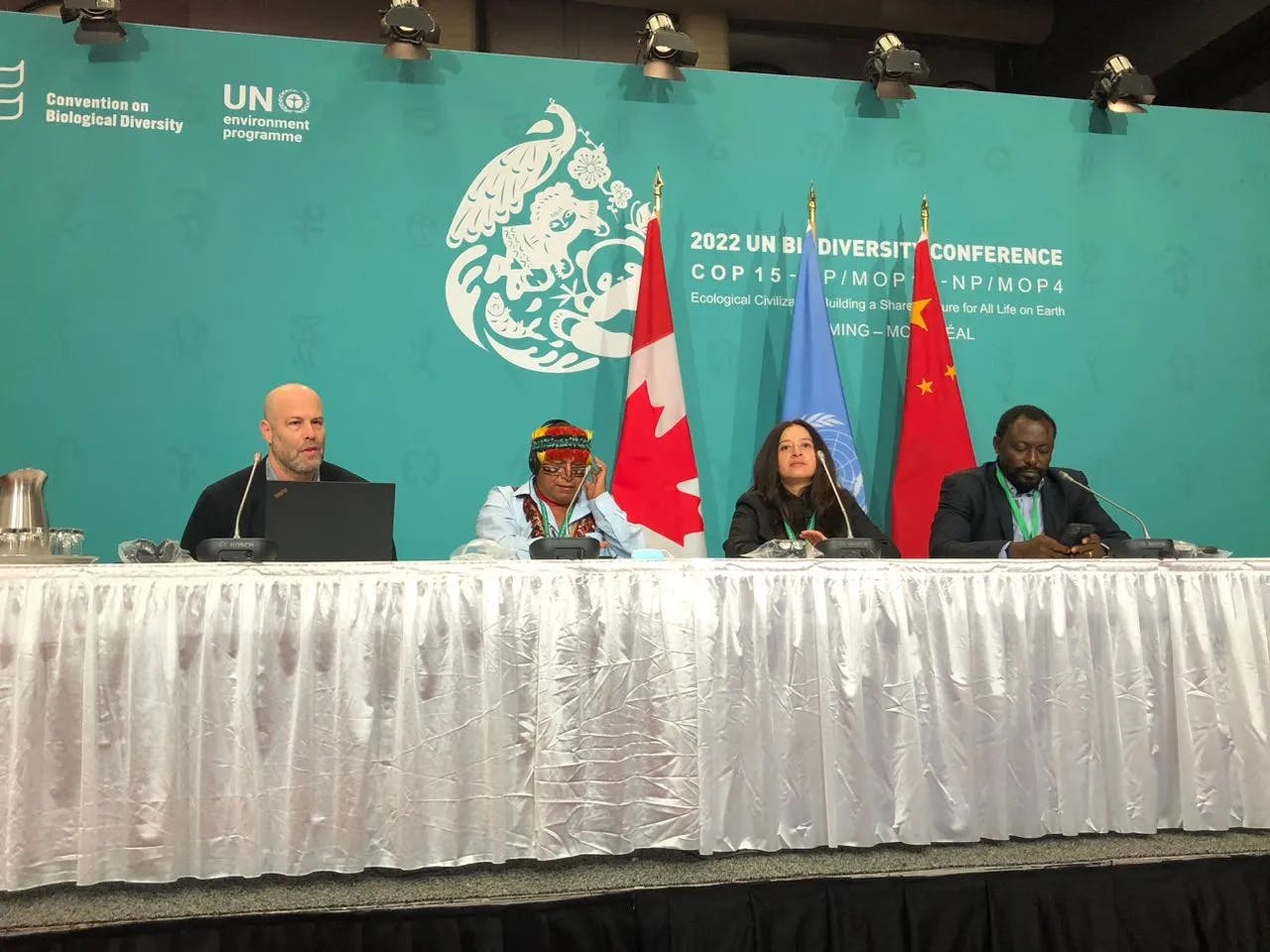An area six times the size of the UK threatened and tens of millions of Indigenous and local community members at risk
December 12, 2022 (Montreal, Canada) — UN Biodiversity COP 15 Press Briefing: Dec 12, 11:30 am, Main Press Conf Room
According to new mapping and analysis in a report released at UN Biodiversity COP 15, oil and gas expansion in the Amazon and Congo Basins is a rapidly-accelerating existential threat to global climate stability and biodiversity, and to tens of millions of Indigenous People and local communities who live inside areas slated for oil and gas exploration and development. This new report titled Crisis Point: Oil and Gas Expansion Threats to Amazon and Congo Basin Tropical Forests and Communities is published by Earth InSight, and the findings underscore the global need for an end to all oil and gas expansion — especially in these and other critical forest basins and ecosystems.
Key findings show that:
Amazon and Congo basins combined:
- Over 135 million hectares of undisturbed tropical forest — an area nearly six times the size of the United Kingdom — has been designated as oil and gas blocks (areas already in production or under exploration)
More than 20% of the total population in these regions or up to 45 million people (inclusive of Indigenous and local communities) now dwell in oil and gas blocks
More than 26,000 populated places (villages, towns, cities, etc.) overlap with oil and gas blocks in these key tropical forest regions.
Amazon
- An estimated 65 million hectares of undisturbed tropical forest (an area nearly twice the size of Poland) now overlap with existing or planned oil and gas blocks in the Amazon Basin
- Over 500 distinct Indigenous nationalities call the Amazon Basin home and more than 25 million hectares of Indigenous Territories are now in oil and gas blocks
- More than 20% of populated places (over 1,800 villages, towns, etc.) in Indigenous Territories are under a current production or designated exploration oil and gas block
- Over 12 million people living in more than 10,000 villages, towns, etc., or more than 20% of populated places in Amazonia are now in oil and gas blocks.
Africa and Congo:
- On a continental scale in Africa, exploration blocks are nearly 4 times the current area in production – representing a significant potential increase for oil and gas expansion.
- Oil and gas exploration blocks overlap more than 30% of undisturbed tropical forests in Africa, of which 90% are in the Congo Basin.
- More than 70 million hectares (an area nearly twice the size of Germany), now overlap with oil and gas blocks in the Congo Basin.
- Over 150 distinct ethnic groups call the Congo Basin home and over 32 million people, or more than 20% of populated places in Congo Basin countries, are now in oil and gas blocks.
Time still remains and solutions exist
Oil and gas drilling is a gateway to deforestation. New policies and financial mechanisms are critical to stop oil and gas expansion in critical areas. Solutions include:
- A moratorium on all industrial activity in primary forests until 2050 in order to safeguard critical ecosystems while allowing time and space to develop appropriate plans and financing
- Expansion of global Indigenous land tenure, access and resource rights, direct funding for co-management, and the requirement of Free, Prior, and Informed Consent (FPIC)
- The Amazonia for Life: 80% by 2025 Declaration from Indigenous federations across the Amazon calling for expanding indigenous rights, territories, and funding, conditioned debt forgiveness, clean financing and supply chains, and ending extractive activities in primary and priority forests, and restoration
- Commitments from banks and financial institutions to stop financing oil and gas expansion – starting with critical forest basins and ecosystems, e.g., through platforms like Exit Amazon Oil and Gas
- Increased country-level commitments to the principles of the Beyond Oil and Gas Alliance
- New frameworks for financing bold climate and biodiversity action including the 10-Point Plan for Financing Biodiversity
- Widespread commitments to the Fossil Fuel Non-Proliferation Treaty
- Unlocking the vast potential in renewables and scaling up direct support to forest communities and other frontline forest defenders.
The Crisis Point report is being released during UN Biodiversity COP 15 — the international gathering of world leaders designed to address the biodiversity crisis. It offers a stark reality check regarding the threat that oil and gas expansion plans pose to the world’s two largest tropical rainforests and the Indigenous and local communities who live within them. This research also builds on findings that were co-published with Rainforest Foundation UK in Congo in the Crosshairs and released at the UN COP 27 climate conference earlier in the year. It also builds upon the excellent research of RAISG and the Amazonia Under Pressure series as well as Amazonia Against the Clock published by the Amazonia for Life: 80% by 2025 coalition.
Amazon and Congo map infographics available for use linked here
-
-
1. According to Grid3 and LandScan figures: Accessible here: https://grid3.org/solution/high-resolution-population-estimates and https://landscan.ornl.gov/
2. Based on analysis showing existing production blocks covering 9.5% of total land area and proposed oil and gas blocks at 37.7%.
3. For the purposes of this report the Congo Basin refers to the dense tropical forest covering six Central African countries: Cameroon, Central African Republic, Democratic Republic of the Congo, Republic of the Congo, Equatorial Guinea, and Gabon.
4. Based on gridded population totals
5. Primary Forest Alliance: Primary Forest Moratorium on Industrial Activity (2022): www.primaryforest.org9.5% of total land area and proposed oil and gas blocks at 37.7%.
6. For the purposes of this report the Congo Basin refers to the dense
7. Amazonia for Life 80% by 2025 Indigenous Federation Declaration (2021): https://amazonia80x2025.earth/declaration#declaration
8. Exit Amazon Oil and Gas Platform: www.exitamazonoilandgas.org
9. Beyond Oil and Gas Alliance: https://beyondoilandgasalliance.com/who-we-are/
10. The 10 Point Plan for Financing Biodiversity: UK Government Policy Platform (2022): https://www.gov.uk/government/publications/political-vision-the-10-point-plan-for-financing-biodiversity/the-10-point-plan-for-financing-biodiversity
11. Fossil Fuel Non Proliferation Treaty: https://fossilfueltreaty.org/
-



%20(1).jpeg?auto=compress%2Cformat)